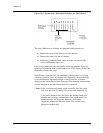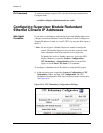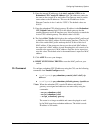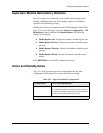
10-12 User Guide for the Avaya P580 and P882 Multiservice Switches, v6.1
Chapter 10
Synchronizing the Active and Standby CPUs
Overview
After installing the active and standby supervisor modules, you must
synchronize them. You can use the Web Agent or CLI to perform the
synchronization.
* Note: If the Active Supervisor module and the Standby (redundant)
Supervisor module are synchronized while the active
supervisor module is being heavily used, TFTP transfers from
the active supervisor module to the Standby Supervisor module
may time out or fail.
* Note: After you synchronize supervisor modules, the standby
supervisor can be accessed only with the default passwords.
The synchronization does not synchronize passwords.
* Note: P580 and P882 supervisor modules must be in the same Fabric
mode (1 or 2) to communicate and to synchronize.
During synchronization, the boot code, software images (app 1 and app 2),
and switch configuration are synchronized. If the boot code or software
images on the standby supervisor differ from those on the active supervisor,
the active supervisor overwrites the boot code or software images on the
standby supervisor. (The boot code and software images on the active
supervisor overwrite those on the standby regardless of which supervisor
has earlier or later software.) To synchronize the two supervisor modules,
the active supervisor performs TFTP uploads to the standby supervisor.
This process takes place over an internal subnet and VLAN.
Once the software images and boot code on the standby and active
supervisors are synchronized, the active supervisor then performs a TFTP
upload of the startup.txt and the.int files.
Once this step is done, and the standby supervisor is reset, and the
synchronization is complete.
The section contains the following information and procedures:
■ Supervisor Module Redundancy Statistics
■ Active and Standby Roles
■ Synchronization Procedure


















